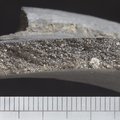Fabric 22 - Black Burnished ware, type 1 (BB1)
Hard fired with abundant sub-angular quartz grains (<1.0mm) but rarely exceeding 0.5mm), some sparse white calcareous inclusions (<1.5mm) and occasional pieces of shale (<4.0mm) (Williams 1977, 163-220).
Reduced to a dark grey or black throughout.
Reduced to a dark grey or black throughout.
Manufacture
Hand-made
Decoration
Varies according to form. Jars are generally characterised by zones of burnishing with a band of incised decoration (commonly lattice) around the middle of the body. The inner surfaces are either untreated or wiped, although the burnishing often covers the interior of the everted rim. Open vessels such as bowls and dishes are usually decorated on both surfaces with a combination of burnishing and/or wiping. Incised decoration commonly consists of lattice or intersecting arcs. Later vessels (3rd to 4th century) may have been slipped but this is often difficult to identify.
Worgret, DORSET
Widely distributed throughout western and north-western areas of England and Wales. Found on most sites in Worcestershire, although in smaller quantities on those which have a high proportion of Malvernian wares (Fabrics 3 and 19). This would appear to be the result of competition between the two industries, with both largely producing cooking vessels.
2 related kilns
Widely distributed throughout western and north-western areas of England and Wales. Found on most sites in Worcestershire, although in smaller quantities on those which have a high proportion of Malvernian wares (Fabrics 3 and 19). This would appear to be the result of competition between the two industries, with both largely producing cooking vessels.
2 related kilns
Roman (1st to 4th century)
The production of BB1 is a continuation of the late pre-Roman Iron Age Durotrigian industry. The assumed date for the arrival of this ware in Worcestershire is c.AD120, the date at which the Durotrigian potters are believed to have captured the whole of the western and northern military markets (Gillam 1976, 57).
The production of BB1 is a continuation of the late pre-Roman Iron Age Durotrigian industry. The assumed date for the arrival of this ware in Worcestershire is c.AD120, the date at which the Durotrigian potters are believed to have captured the whole of the western and northern military markets (Gillam 1976, 57).
Hardness
Hard
Feel
Smooth
Fracture
Hackly
Surface treatment
Pattern burnishing
Core colour
Black
Int surface colour
Black
Ext surface colour
Black
| DB ID | Modified | Description | Frequency | Size | Sorting | Rounding |
|---|---|---|---|---|---|---|
| 146 | 0 | Quartz | Abundant | Medium | Sub-angular | |
| 147 | 0 | White calcareous fragments | Sparse | Coarse | ||
| 148 | 0 | Shale | Sparse | Coarse | Ill-sorted |

